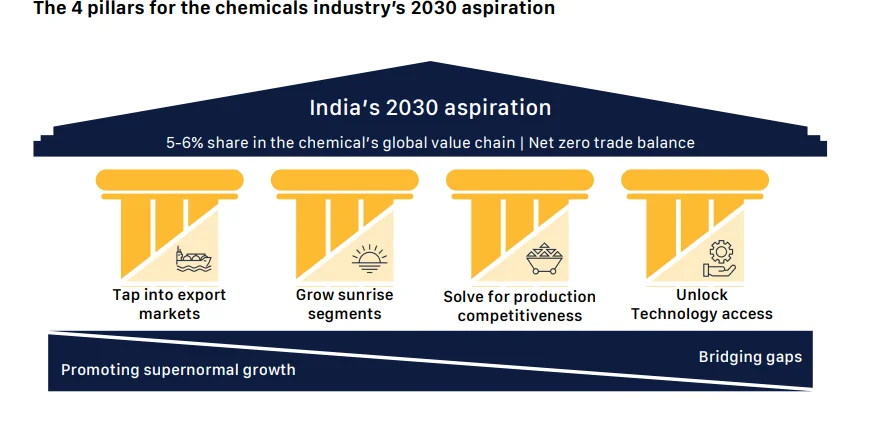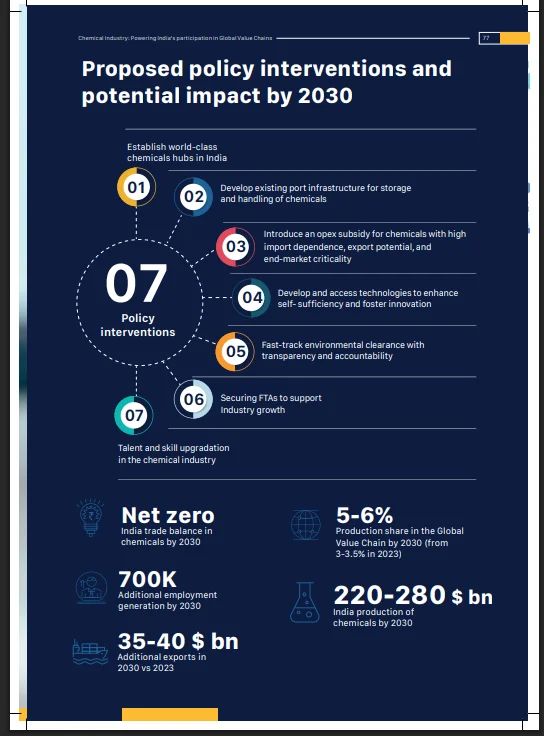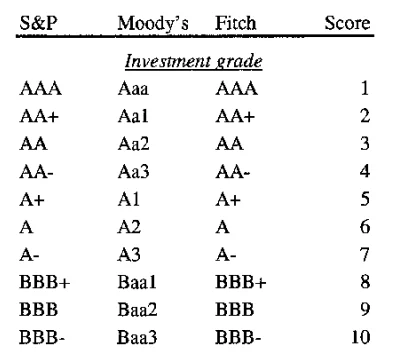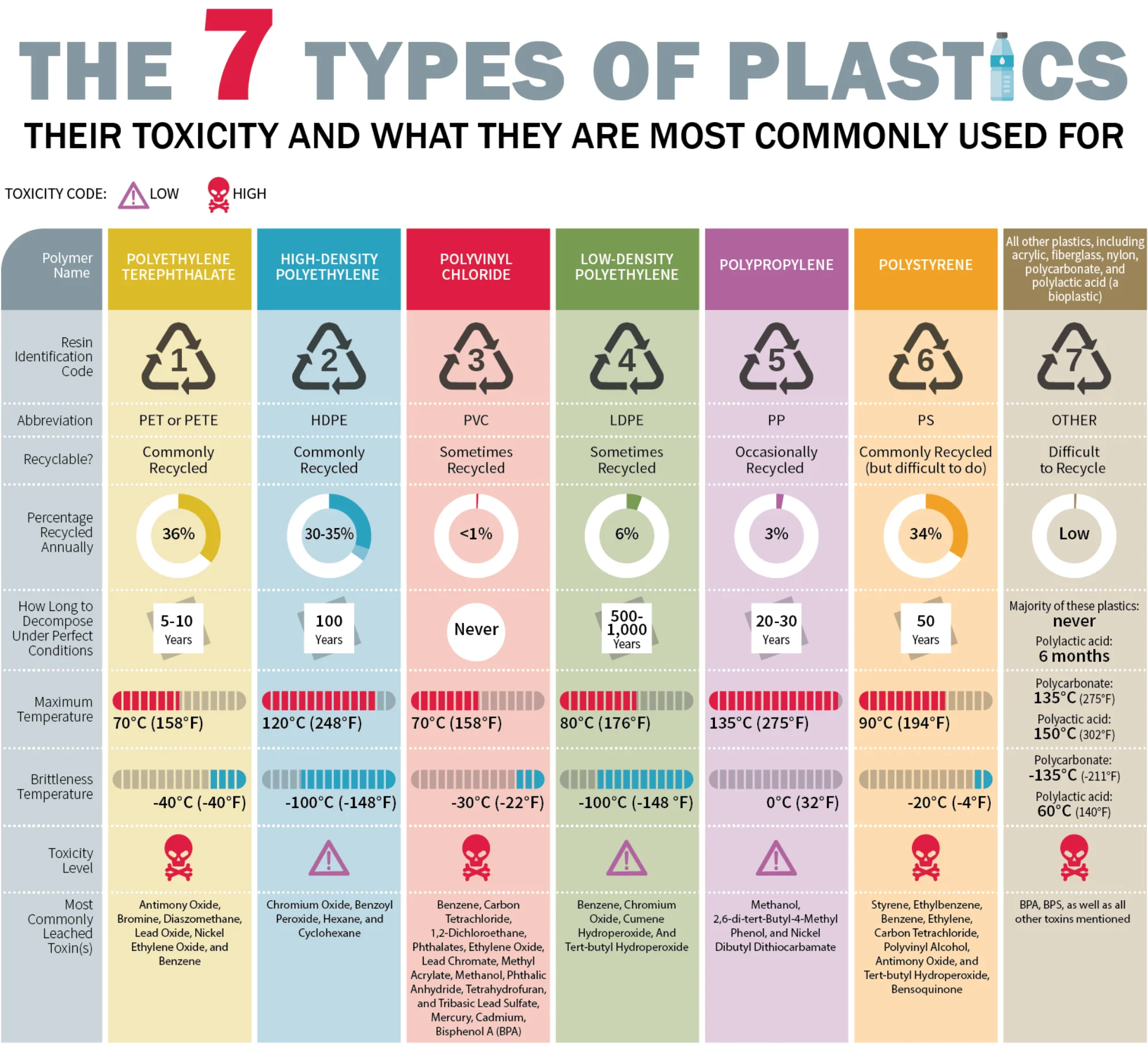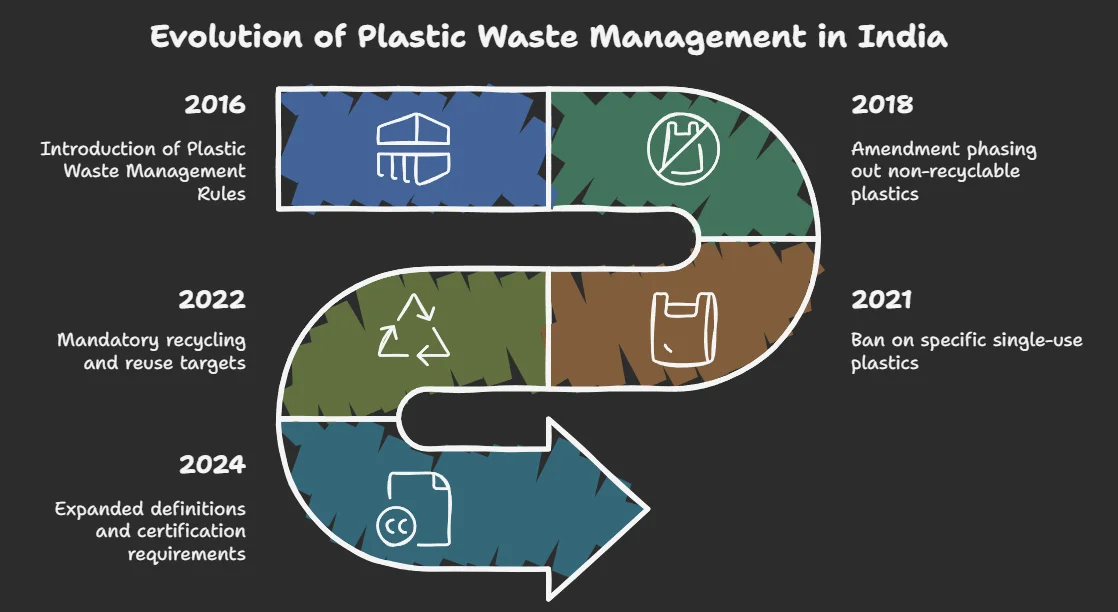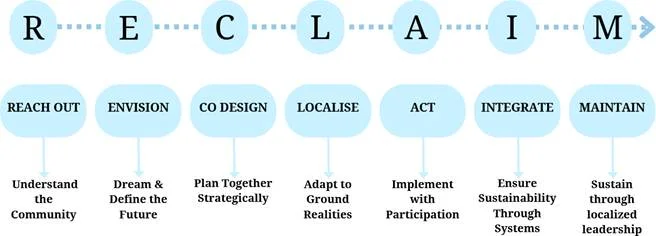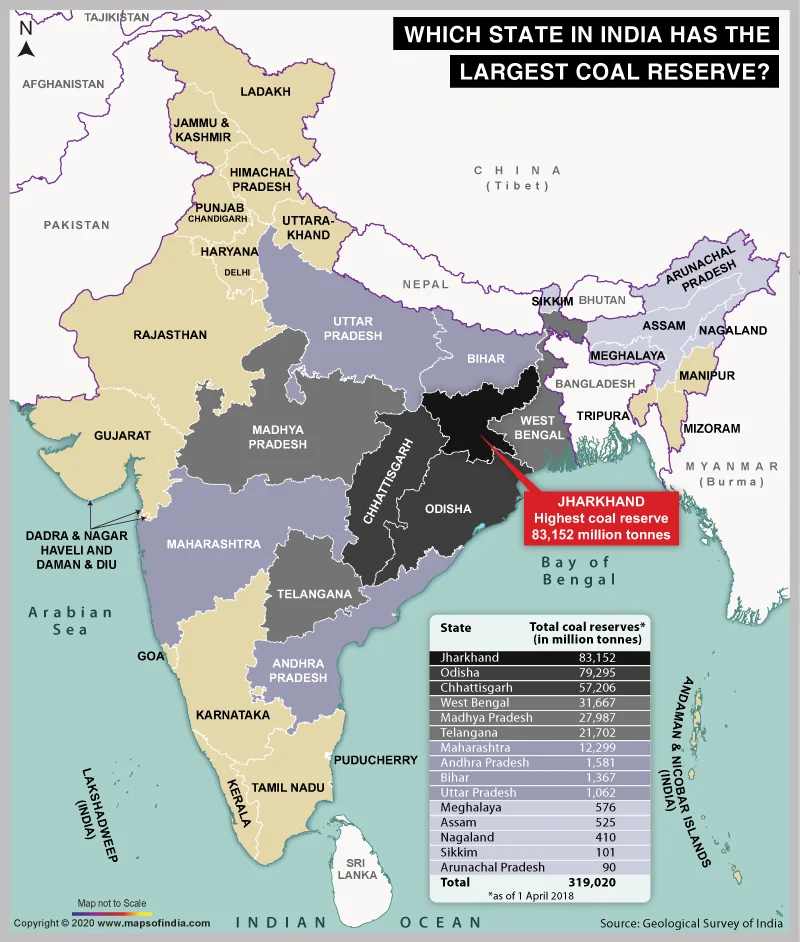Economy
NITI Aayog Report on Chemical Industry
For Prelims: NITI Aayog, Global Value Chains, Chemical Industry, Viability Gap Funding (VGF), Free Trade Agreements (FTAs), PLI Scheme, Extended Producer Responsibility (EPR), Anti-dumping, Carbon Border Adjustment Mechanism (CBAM), MSME.
For Mains: Status and challenges associated with the chemical industry in India, NITI Aayog proposed policy interventions to promote chemical industry.
Why in News?
NITI Aayog released its report titled ‘Chemical Industry: Powering India’s Participation in Global Value Chains’, outlining an ambitious roadmap for India to become a global chemical manufacturing powerhouse.
- The report envisions India achieving a 12% share in global chemical value chains (GVC) and a USD 1 trillion output by 2040.
What is the Status of the Chemical Industry in India?
- Global Standing: India ranks as the 6th largest chemical producer globally, contributing over 7% to the manufacturing GDP.
- The chemical sector supports critical industries such as pharma, textiles, agriculture, and construction.
- Feedstock Utilization: India shows over-concentration in bulk chemical production, with 87% of benzene used for alkylbenzene, chlorobenzene, and cumene, unlike the global trend where only 25% is used similarly and more goes to complex derivatives.
- Low Share in Global Value Chains (GVC): India holds only a 3.5% share in global chemical value chains, with a USD 31 billion trade deficit (2023).
- The sector remains fragmented, dominated by MSMEs, with growth concentrated in Gujarat, Maharashtra, and Tamil Nadu.
- Skill and Innovation Gaps: There is a 30% shortage of skilled professionals, especially in green chemistry, nanotechnology, and process safety.
- R&D investment is just 0.7% of industry revenue, well below the global average of 2.3%, limiting innovation in high-value and sustainable chemicals.
- Import Dependence: The sector is heavily import-dependent, sourcing over 60% of critical Active Pharmaceutical Ingredients (APIs) from China, and other feedstocks from Gulf countries.
- Regulatory Bottlenecks: clearances and regulatory delays add to operational costs, with delays of up to 12-18 months for approvals.
What are the Opportunities in India’s Chemical Industry?
- Rising Domestic Demand: India’s consumer and industrial growth is fueling demand in agrochemicals (4th-largest producer), pharmaceuticals (3rd-largest drug producer), and construction & automotive (paints, adhesives, polymers).
- Refinery expansions (e.g., Reliance, Nayara, BPCL) will further boost petrochemical production.
- Job Creation: The sector is expected to generate 7 lakh skilled jobs by 2030, particularly in areas such as petrochemicals, research, and logistics.
- Global Supply Chain Shift: India can capture the shifting global chemical trade from China, especially in dyes & pigments, surfactants, textile chemicals, and electronic chemicals used in semiconductor and EV battery manufacturing.
- Green & Sustainable Chemicals: The global shift toward bio-based and green chemicals is creating demand for bio-plastics, and bio-lubricants where India’s sugar and biomass resources can support the production of bio-based chemicals.
What are the Proposed Policy Interventions by NITI Aayog to Promote Chemical Industry?
- World-Class Chemicals Hubs: Establish hubs by forming an Empowered Committee with a dedicated Chemical Fund for shared infrastructure and Viability Gap Funding (VGF).
- Port Infrastructure: Set up a Chemical Committee for ports and develop 8 high-potential chemical clusters near ports to enhance logistics and export capabilities.
- OPEX Subsidy Scheme: Introduce an OPEX Subsidy Scheme to incentivize incremental production based on import reduction, export potential, single-source dependency, and end-market criticality.
- Develop & Access Technologies: Promote self-sufficiency and innovation by disbursing R&D funds for industry-academia collaboration via DCPC and partnering with MNCs to bridge technological gaps.
- Fast-Track Environmental Clearances: Simplify and expedite Environmental Clearances (EC) through an audit committee under DPIIT to ensure compliance.
- Secure FTAs: Pursue targeted FTAs with tariff quotas and duty exemptions on critical raw materials and feedstocks; improve FTA awareness, origin proof procedures, and export competitiveness.
- Talent & Skill Upgradation: Expand ITIs and specialized training institutes to meet the growing demand for skilled labor, and strengthen industry-academia partnerships for courses in petrochemicals, polymer science, and industrial safety.
India’s Initiatives to Support the Chemical Industry
- Production linked incentive (PLI) Scheme: PLI Scheme for Promotion of Domestic Manufacturing of Critical Key Starting Materials (KSMs), Drug Intermediates and APIs aims to boost domestic production by encouraging the establishment of Greenfield plants.
- PCPIR: The Petroleum, Chemicals and Petrochemicals Investment Region (PCPIR) set up at Paradip has attracted investments worth USD 8.84 billion, resulting in employment of about 40,000 people.
- Jan Aushadhi Kendras: The Government aims to open 25,000 Jan Aushadhi Kendras to ensure affordable access to medicines.
What Steps are Needed to Strengthen the Chemical Industry?
- Global Integration: Sign Mutual Recognition Agreements (MRAs) to align Indian chemical standards with global norms, and establish a dedicated chemical export promotion council for market access and brand building.
- Strengthen Safety Standards: Enforce strict safety norms and implement real-time monitoring systems in chemical clusters to enhance safety and compliance.
- Promote green and sustainable chemistry through waste recycling, low-emission processes, and incentivize adoption of zero liquid discharge (ZLD) and clean production technologies.
- Financial & Investment Support: Ease access to capital by offering lower interest loans to MSME chemical manufacturers and promoting venture capital funding for specialty chemical startups, while ensuring risk mitigation through subsidized insurance.
- Skill Development: Upskill the workforce through industry-aligned chemical engineering courses focusing on process safety and green technology.
- Enhance safety protocols by mandating Process Safety Management (PSM) audits and enforcing the Chemical Accidents Rules, 1996 more strictly.
Conclusion
India’s chemical industry, a GDP growth driver, aims to become a global manufacturing hub by 2030 through policy interventions like chemical hubs, OPEX subsidies, FTAs, and an R&D push. Overcoming import dependency, regulatory hurdles, and sustainability challenges requires global integration, safety enforcement, green chemistry, and skill development to achieve USD 1 trillion market potential.
|
Drishti Mains Question: Q. Discuss the status, challenges, and policy measures required to make India a global leader in the chemical industry. |
UPSC Civil Services Examination, Previous Year Questions (PYQs)
Prelims
Q. In India, ‘extend producer responsibility’ was introduced as an important feature in which of the following? (2019)
(a) The Bio-medical Waste (Management and Handling) Rules, 1998
(b) The Recycled Plastic (Manufacturing and Usage) Rules, 1999
(c) The e-Waste (Management and Handling) Rules, 2011
(d) The Food Safety and Standard Regulations, 2011
Ans: (c)
Indian Economy
Reforming the Global Sovereign Credit Rating System and MDBs
For Prelims: Foreign Direct Investment (FDI), GDP, Fiscal Deficit, Inflation, Balance of Payments (BoP), Foreign Reserves, GST, Insolvency and Bankruptcy Code (IBC), Debt-to-GDP, BRICS, G20, IMF.
For Mains: Concerns associated with the global sovereign credit rating system and MDBs and steps needed to reform them.
Why in News?
At the 4th International Conference on Financing for Development (FFD4) held in Seville, Spain, India’s Finance Minister advocated for reforming the global sovereign credit rating systems and multilateral development banks (MDBs) to promote equity, inclusivity, and sustainable development.
What are Multilateral Development Banks?Click Here to Read: Multilateral Development Banks |
What is the Sovereign Credit Rating System?
- About: A Sovereign Credit Rating is an independent evaluation of a country’s creditworthiness, providing investors with insights into the risk level of investing in its debt, including political risks.
- Beyond accessing external debt markets, countries seek such ratings to help attract Foreign Direct Investment (FDI).
- Credit Rating Agencies: The Big Three global rating agencies are Standard & Poor’s (S&P), Moody’s, and Fitch Ratings, all of which are based in the United States.
- Other notable agencies include DBRS (Canada), JCR (Japan), and Dagong (China).
- Rating Scales: Credit ratings range from AAA (highest) to D (default).
- Ratings from AAA to BBB- (S&P/Fitch) or Aaa to Baa3 (Moody’s) are considered investment grade; anything lower is speculative or junk grade.
- Parameters Used: Sovereign credit ratings are based on key parameters such as a country’s GDP growth rate, fiscal deficit and public debt levels, inflation and monetary stability, political stability and governance, balance of payments (BoP), and foreign reserves including current account balance.
- Impact of Ratings: A higher rating lowers borrowing costs for governments and improves investor confidence.
- A downgrade raises borrowing costs and may trigger capital outflows.
- India’s Sovereign Credit Rating: India’s sovereign credit rating stands at Baa3 from Moody’s and BBB- from S&P and Fitch, all representing the lowest investment grade, though India maintains that its strong macroeconomic fundamentals warrant a higher rating.
Sovereign Credit Rating (SCR) in India
- In India, there are six credit rating agencies namely, CRISIL, ICRA, CARE, SMERA, Fitch India and Brickwork Ratings.
- Each credit rating agency uses its own methodology to assess entities like companies, governments, non-profits, and securities.
- They evaluate factors such as financial statements, debt levels, repayment history, and creditworthiness, providing investors with insights to make informed investment decisions.
- The SEBI (Credit Rating Agencies) Regulations, 1999 of the Securities and Exchange Board of India Act, 1992 govern credit rating agencies in India.
- CareEdge (parent company CARE Ratings Ltd) became the first Indian credit rating agency to enter the global scale ratings space, including sovereign ratings.
Why does India Want Reforms in the Current Sovereign Credit Rating System?
- Bias Against Developing Economies: Despite having strong macroeconomic fundamentals, India holds a BBB- rating (just above junk status), whereas countries like Italy and Spain, with weaker growth and higher debt levels, receive better credit ratings.
- For instance, Italy’s debt-to-GDP ratio is averaged 118%, yet it is rated BBB by S&P, compared to India’s BBB- (debt-to-GDP ratio is 80%).
- In December 2023, finance ministry economists had questioned the three big global rating agencies for keeping India’s rating static at the lowest investment grade for the last 15 years despite it moving up the ladder from 12th largest to become 5th largest economy.
- Flawed Debt Assessment: Despite India’s debt being largely domestic and low-risk, rating agencies assess it like foreign currency debt and often overlook India’s high growth, which makes its debt more sustainable than that of stagnant economies like Japan or the USA.
- Overemphasis on Perceptual Factors: Credit ratings often rely on subjective factors like political stability surveys, which may be biased or outdated, while India’s strong GDP growth, USD 600+ billion forex reserves, and key reforms like GST and Insolvency and Bankruptcy Code (IBC) are frequently underweighted.
- Pro-Cyclical Downgrades: During economic stress (e.g., Covid-19), agencies often downgrade countries, raising borrowing costs when funds are most needed. E.g., in 2020, Moody's downgraded India’s rating from Baa2 to Baa3 despite stimulus measures.
- Conflict of Interest: Most global rating agencies, including Moody’s, S&P, Fitch, are paid by the entities they rate, raising concerns about credibility, independence, and developed-world bias.
- There is a lack of Global South-led alternatives, limiting balanced perspectives in sovereign credit assessments.
- Failure to Predict Major Crises: Rating agencies failed to predict the 2008 financial crisis, assigning high ratings to risky assets, which damaged their credibility, yet their assessments still heavily influence global capital flows.
- They also lack transparency in sovereign rating methodologies, and the absence of a uniform global standard affects objectivity and fairness.
What are the Key Challenges Related to MDBs?Click Here to Read: Key Challenges Related to MDBs |
What Steps are Needed to Reform the Sovereign Credit Rating System?
- Greater Transparency: Rating agencies should disclose the weightage assigned to key metrics like GDP growth, debt-to-GDP, and political stability, and undergo independent audits to ensure transparency and prevent bias.
- They must also incorporate country-specific factors in their assessments, such as India’s domestic debt profile and demographic dividend.
- Increased Objectivity: Replace perception-based metrics with hard data (e.g., inflation control, forex reserves, digital infrastructure) and use AI and Big Data to integrate real-time indicators like GST collections and UPI transactions for more dynamic assessments.
- Alternative Credit Rating Agencies (CRAs): Encourage emergence of rating agencies from the Global South, including India, BRICS, or G20 nations to counter Western dominance, while also strengthening Indian agencies like CRISIL and ICRA to compete globally.
- Regulatory Oversight & Accountability: Create a global supervisory body, possibly under IMF, or G20 to audit and regulate rating practices.
- Incorporate Non-Economic Indicators: Credit ratings should include parameters like climate resilience, digital capacity, and policy reforms, broadening the focus beyond fiscal metrics to assess long-term sustainability and reform orientation.
- Promote Peer Comparability: Ratings should be updated in real time to reflect rapid macroeconomic changes, and peer comparison dashboards should be introduced to minimize perception asymmetry.
What Reforms are Necessary in MDBs?Click Here to Read: Reforms Necessary in MDBs |
Conclusion
India advocates reforming the biased sovereign credit rating system and outdated MDBs that undervalues developing economies. With strong fundamentals yet stagnant ratings and unsustainable funding, India seeks transparent, data-driven assessments and alternative agencies to counter Western dominance. Reforms must incorporate real-time indicators, climate resilience, and regulatory oversight to ensure fair global financing and reflect true economic potential.
|
Drishti Mains Question: Q. Critically analyze the limitations of the current sovereign credit rating system and suggest reforms to make it equitable for developing countries. |
UPSC Civil Services Examination, Previous Year Question (PYQ)
Prelims
Q. Consider the following statements:
- In India, credit rating agencies are regulated by the Reserve Bank of India.
- The rating agency popularly known as ICRA is a public limited company.
- Brickwork Ratings is an Indian credit rating agency.
Which of the statements given above are correct?
(a) 1 and 2 only
(b) 2 and 3 only
(c) 1 and 3 only
(d) 1, 2 and 3
Ans (b)
Biodiversity & Environment
Plastic Waste a Public Health Threat
For Prelims: Microplastics, Single-Use Plastics, Virgin plastic, Endocrine-disrupting Chemicals
For Mains: Plastic Waste Management, Conservation Environmental Pollution & Degradation Government Policies & Interventions.
Why in News?
Studies have found alarming levels of microplastics and endocrine-disrupting chemicals (EDCs) in human tissues. India, as the world’s top plastic waste generator, faces a growing public health crisis linked to fertility issues, cancers, and chronic diseases.
How are Microplastics and EDC in Plastics Affecting Human Health?
- Microplastics: Microplastics are plastic particles smaller than 5 mm, formed either intentionally (primary) or through the breakdown of larger plastics (secondary).
- Primary microplastics include microbeads in cosmetics and fibres from textiles.
- Secondary microplastics result from the degradation of plastic waste due to sunlight and ocean waves.
- Microplastics are biologically active and have been found in blood, lungs, heart, placenta, breast milk, ovarian follicular fluid, and semen.
- Affect:
- Men: Linked to lower sperm count, motility, abnormal morphology, and hormonal imbalance.
- Women: Associated with poor egg quality, menstrual issues, miscarriage risk, Polycystic Ovary Syndrome (PCOS), and endometriosis.
- Endocrine-disrupting Chemicals: EDCs are natural or human-made chemicals that may mimic, block, or interfere with the body’s hormones, which are part of the endocrine system.
- Plastics often carry EDCs like Bisphenol A (BPA) (in water bottles, food containers), phthalates such as DEHP and DBP (in cosmetics, toys, IV tubes), and PFAS (in food packaging, non-stick cookware).
- Affect: These chemicals mimic or block hormones like estrogen and testosterone, disrupting reproductive health and metabolic functions.
- Plastic additives like DEHP, BPA, and phthalates are classified as probable carcinogens.
- EDCs also contribute to obesity, type 2 diabetes, thyroid disorders, and metabolic syndrome by mimicking cortisol and disrupting insulin response.
What are the Concerns with Plastic Pollution in India?
- Massive and Mismanaged Plastic Waste Generation: India contributes 9.3 million tonnes of plastic pollution annually (burning 5.8 mt and releasing 3.5 mt into the environment) making it the world’s largest polluter, surpassing Nigeria, Indonesia, and China, according to a 2024 Nature study.
- Environmental and Health Hazards: Open burning, a common disposal method, emits toxic pollutants that degrade air quality and harm respiratory health.
- Plastic debris clogs rivers and drains, worsening urban flooding and threatening aquatic biodiversity.
- Single-use plastics persist for centuries, polluting land and oceans and harming marine life. Cities like Mumbai see high microplastic exposure, while phthalate levels in drinking water exceed safe limits in Delhi, Jabalpur, and Chennai.
- Children in polluted areas face increased risks of early puberty, learning issues, and obesity due to EDCs.
- Economic and Agricultural Impact: India could lose USD 133 billion in plastic packaging value by 2030 if waste continues to go uncollected.
- Microplastics in soil from plastic use in agriculture and poor wastewater treatment are degrading soil fertility and threatening food safety.
- The e-commerce boom has escalated plastic packaging waste, most of which is non-recyclable.
- Weak Infrastructure and Regulatory Oversight: Insufficient sanitary landfills, poor segregation at source, and a lack of advanced recycling technology hinder effective waste processing.
- Informal sector recyclers, though critical, operate unregulated, leading to gaps in plastic tracking and environmental safety.
- The enforcement of policies such as the Plastic Waste Management (Amendment) Rules, 2024 and Extended Producer Responsibility (EPR) remains inconsistent and inadequate.
- Rise in Single-Use Plastics (SUPs), which account for 43% of total plastic waste. Despite regulatory bans, enforcement remains poor due to the low cost and easy availability of such plastics.
- Data and Policy Gaps: Official collection rates (95%) are overstated; real rates are closer to 81%, hampering effective planning.
- Global North-South Divide: Despite lower per capita plastic use (0.12 kg/day), India’s poor disposal systems result in more environmental leakage compared to high-income countries with better infrastructure.
India’s Initiatives Related to Plastic Waste Management
How Can India Combat the Growing Threat of Plastics?
- Microplastic Filtration Systems: Invest in advanced water treatment technologies to filter microplastics to reduce plastic contamination in the environment and the food chain.
- The National Plastic Waste Reporting Portal will help track and monitor waste more effectively.
- Behavioural Change and Public Awareness: Launch national campaigns under Swachh Bharat Mission 2.0 and Mission LiFE to educate citizens about plastic hazards and encourage plastic-free lifestyles.
- Integrate environmental education in school curricula and promote reduce-reuse-recycle values from an early age.
- Encourage use of eco-friendly alternatives (glass, cloth, jute, biodegradable polymers).
- Biomonitoring and Public Health Surveillance: Establish national biomonitoring programs to assess the levels of EDCs in blood, urine, and breast milk, and fund longitudinal studies to track health outcomes such as fertility issues, metabolic diseases, and cancer.
- Regular surveillance of plastic pollution and its effects on public health should be implemented to inform policymaking.
- Fiscal Measures and Economic Incentives: Increase eco-taxes or cess on virgin plastic production and packaging to limit production.
- Provide subsidies and tax benefits for industries investing in eco-friendly packaging and plastic alternatives.
- Stronger Regulation and Enforcement: India must move beyond end-of-pipe waste solutions by revising the Plastic Waste Management Rules to address low-dose chemical toxicity (such as EDCs), microplastic contamination, and the heightened vulnerability of children and pregnant women.
- Under the PWM Rules 2024, Producers, Importers, and Brand Owners (PIBOs) are legally obligated to collect and responsibly process the plastic packaging they introduce, including compostable and biodegradable plastics.
- While an online submission and tracking system has been introduced to ensure compliance, its effectiveness depends on robust implementation and strict monitoring.
- Harmful plastic additives should be classified as toxic under the Environment Protection Act, 1986.
Additionally, the EPR mechanism must be strengthened through material-specific targets, third-party audits, and traceability via plastic credits to ensure accountability and circularity.
- Under the PWM Rules 2024, Producers, Importers, and Brand Owners (PIBOs) are legally obligated to collect and responsibly process the plastic packaging they introduce, including compostable and biodegradable plastics.
- Collaborate on Global Plastic Initiatives: India should align with global initiatives like the UN Clean Seas Campaign to share knowledge and best practices for reducing plastic waste globally.
|
Drishti Mains Question: India is now the world’s top plastic polluter. Examine the socio-economic and health impacts of plastics. Suggest reforms to tackle this crisis. |
UPSC Civil Services Examination, Previous Year Questions (PYQs)
Prelims
Q.1 In India, ‘extend producer responsibility’ was introduced as an important feature in which of the following? (2019)
(a) The Bio-medical Waste (Management and Handling) Rules, 1998
(b) The Recycled Plastic (Manufacturing and Usage) Rules, 1999
(c) The e-Waste (Management and Handling) Rules, 2011
(d) The Food Safety and Standard Regulations, 2011
Ans: (c)
Q.2 How is the National Green Tribunal (NGT) different from the Central Pollution Control Board (CPCB)? (2018)
- The NGT has been established by an Act whereas the CPCB has been created by an executive order of the Government.
- The NGT provides environmental justice and helps reduce the burden of litigation in the higher courts whereas the CPCB promotes cleanliness of streams and wells, and aims to improve the quality of air in the country.
Which of the statements given above is/are correct?
(a) 1 only
(b) 2 only
(c) Both 1 and 2
(d) Neither 1 nor 2
Ans: (b)
Q. Why is there a great concern about the ‘microbeads’ that are released into the environment? (2019)
(a) They are considered harmful to marine ecosystems.
(b) They are considered to cause skin cancer in children.
(c) They are small enough to be absorbed by crop plants in irrigated fields.
(d) They are often found to be used as food adulterants.
Ans: (a)
Mains
Q: What are the impediments in disposing the huge quantities of discarded solid waste which are continuously being generated? How do we remove safely the toxic wastes that have been accumulating in our a habitable environment? (2018)
Facts for UPSC Mains
RECLAIM Framework for Mine Closure
Why in News?
The Ministry of Coal launched the RECLAIM Framework to ensure just and sustainable mine closures through inclusive community participation.
What is RECLAIM Framework?
- About: An India-specific policy tool developed by the Coal Controller Organisation (Ministry of Coal) in partnership with the Heartfulness Institute, aimed at guiding inclusive and sustainable mine closures.
- Objective: To ensure a just, inclusive, and locally relevant transition for mining-affected communities by promoting community participation, ecological restoration, and long-term socio-economic recovery.
- It focuses on gender inclusivity, vulnerable groups, and convergence with Panchayati Raj Institutions to build resilient post-mining economies.
- Key Features:
- It promotes community-centric planning through local participation, with emphasis on gender equity, vulnerable groups, and livelihood diversification.
- It ensures institutional convergence by aligning with Panchayati Raj Institutions and local governance structures, and provides actionable, field-tested tools and methodologies tailored to Indian mining regions for effective implementation.
- Phases of Implementation: Pre-Closure (needs assessment, capacity building), Closure (participatory plan execution), and Post-Closure (monitoring, livelihood support, asset repurposing).
- Significance:
- Mitigates socio-economic and environmental impacts of mine closures
- Supports SDGs and promotes transparency, accountability, and trust
- Serves as a replicable model for other resource-dependent sectors and states.
What are the Key Challenges Related to Coal Mine Closure?
- Gap Between Policy and Practice: Despite mine closure guidelines since 2009, only 3 coal mines have been formally closed.
- Of the 299 non-operational mines (2024), only 8 applied for closure, while the rest remain abandoned or discontinued without scientific closure, causing ecological degradation, methane emissions, and increased risks of accidents and illegal mining.
- Lack of Proper Rehabilitation: Unsustainable mining and degradation of local resources have led to unemployment and forced migration, reducing community capacity and resource availability during mine closure. This hampers local participation and poses a major challenge to implementing effective and inclusive closure.
- Lack of Land Return Framework: The lack of clear mine closure and land return policies often results in land being transferred to other departments or used for renewable projects without scientific closure or community consultation, delaying just transition efforts, especially in states like Jharkhand.
- The 2024 draft Coal Bearing Areas (CBA) Amendment Bill proposes returning unused land to original owners, but lacks enforcement clarity.
- Technological & Economic Challenges: India's mine closure plans are mostly technical, neglecting social, economic, and environmental justice aspects.
- High escrow requirements (Rs 14 lakh/ha for opencast mines) deter mine operators from undertaking closure activities.
About Coal
- About: Coal is a fossil fuel formed from the remains of ancient vegetation, found in the form of sedimentary rock, and often referred to as 'Black Gold' due to its high economic value.
- It is a conventional energy source widely used for domestic fuel, thermal power generation, and in industrial sectors like iron and steel and railway steam engines.
- Global Producers: As of 2025, top 5 coal-producing countries are China, India, Indonesia, United States and Russia.
- Coal Distribution in India:
- Gondwana Coal Fields: Gondwana coal contributes 98% of India’s coal reserves and 99% of its production, providing superior and metallurgical-grade coal.
- Major deposits are in the Damodar (Jharkhand–West Bengal), Mahanadi (Chhattisgarh–Odisha), Godavari (Maharashtra), and Narmada (Madhya Pradesh) valleys.
- Tertiary CoalFields: Tertiary coal fields (15–60 million years old) have lower carbon content but are rich in moisture and sulphur.
- They are mainly found in extra-peninsular regions such as Assam, Meghalaya, Nagaland, Arunachal Pradesh, Jammu & Kashmir, Darjeeling foothills (West Bengal), Rajasthan, Uttar Pradesh, and Kerala.
- Gondwana Coal Fields: Gondwana coal contributes 98% of India’s coal reserves and 99% of its production, providing superior and metallurgical-grade coal.
- Classification of Coal:
- Anthracite (80–95%): Highest carbon content, limited presence in Jammu & Kashmir.
- Bituminous (60–80%): Most abundant, found in Jharkhand, Odisha, Chhattisgarh, West Bengal, and Madhya Pradesh.
- Lignite (40–55%): Lower grade, high moisture, found in Tamil Nadu, Rajasthan, and Assam (Lakhimpur).
- Peat (<40%): Initial stage of coal formation with low heating value.
|
Drishti Mains Question: Critically analyse the socio-economic and ecological consequences of unscientific coal mine closures in India. How does the RECLAIM Framework aim to address these issues? |
UPSC Civil Services Examination Previous Year Question (PYQ)
Prelims
Q1. Consider the following statements: (2019)
- The coal sector was nationalized by the Government of India under Indira Gandhi.
- Now, coal blocks are allocated on lottery basis.
- Till recently, India imported coal to meet the shortages of domestic supply, but now India is self-sufficient in coal production.
Which of the statements given above is/are correct?
(a) 1 only
(b) 2 and 3 only
(c) 3 only
(d) 1, 2 and 3
Ans: (a)
Mains
Q. Despite India being one of the countries of Gondwanaland, its mining industry contributes much less to its Gross Domestic Product (GDP) in percentage. Discuss. (2021)
Q. “In spite of adverse environmental impact, coal mining is still inevitable for development”. Discuss. (2017)
Rapid Fire
SC Upholds Legislative Authority of State
The Supreme Court ruling in the Nandini Sundar vs. State of Chhattisgarh 2011 case sheds light on the role of state legislatures in passing laws and their relationship with judicial orders in India’s democratic framework.
Nandini Sundar vs. State of Chhattisgarh Case, 2011
- Background: In 2011, the Supreme Court directed the Chhattisgarh government to cease the use of Special Police Officers (SPOs) in anti-Maoist operations, citing their inadequate training and violations of Articles 14 and 21 of the Constitution.
- In response, the state enacted the Chhattisgarh Auxiliary Armed Police Forces Act, enabling the formation of an auxiliary force resembling the earlier Salwa Judum and Koya Commandos.
- The petitioners filed a contempt plea, alleging that this new law contravened the spirit of the 2011 judgment.
- Supreme Court Ruling: The Supreme Court rejected the contempt plea, noting that Chhattisgarh had complied with its 2011 directions and submitted requisite reports. It held that a state legislature has the authority to enact laws, as long as they are not unconstitutional or ultra vires.
- Reaffirming the doctrine of separation of powers, the Court clarified that legislative actions can only be challenged on grounds of constitutional validity or legislative competence.
- It emphasized that a legislature may enact new laws, remove the basis of a judgment, or validate laws struck down, all within its constitutional domain.
- Similar Judicial Pronouncements: SC in Indian Aluminium Co. vs. State of Kerala (1996), upheld the legislature’s power to amend laws or enact retrospective legislation to remove the basis of a judgment, without directly overruling it.
Salwa Judum & Koya Commandos
- Salwa Judum is a state-backed anti-Maoist movement launched in 2005 in Chhattisgarh, involving the mobilization of tribal youth to counter Maoist insurgents.
- Koya Commandos were tribal youths, primarily from the Koya tribe, recruited as Special Police Officers (SPOs) in Chhattisgarh under the Salwa Judum movement to aid in anti-Naxalite operations.
| Read More: SC Verdict on Governors' Powers over State Bills |
Rapid Fire
Mahabodhi Temple
The Supreme Court declined to entertain a petition under Article 32 challenging the Bodh Gaya Temple Act, 1949, which sought exclusive control of the Mahabodhi Temple by the Buddhist community.
- The Bodh Gaya Temple Act, 1949 was enacted to ensure the better management of the Mahabodhi Temple, one of Buddhism’s holiest sites.
Mahabodhi Temple
- About: It marks the site where Gautam Buddha attained enlightenment under the Mahabodhi Tree. The original temple was built by Emperor Ashoka in the 3rd century BC, while the present structure dates to the 5th–6th centuries.
- Architectural Features: It includes the 50 m high grand temple (Vajrasana), the sacred Bodhi Tree, and six other sacred sites of Buddha's enlightenment, surrounded by ancient Votive stupas.
- It is among the earliest brick temples from the Gupta period, and the Vajrasana (Diamond Throne) was originally installed by Emperor Ashoka to mark Buddha’s meditation spot.
- Sacred Sites: Bodhi Tree (direct descendant of the tree under which Buddha attained enlightenment), Animesh Lochan Chaitya (Site of Buddha's meditation after attaining enlightenment), etc.
- Recognition: It has been a UNESCO World Heritage Site since 2002.
| Read More: Corridor Projects for Vishnupad and Mahabodhi Temples |
Rapid Fire
Chemical Weapons Convention
India hosted the 23rd Regional Meeting of National Authorities of States Parties in Asia under the Chemical Weapons Convention (CWC).
Chemical Weapons Convention
- About: CWC is a multilateral treaty banning chemical weapons and requiring their destruction within the stipulated time.
- It came into force in 1997 and its implementation is overseen by the Organisation for the Prohibition of Chemical Weapons (OPCW) with 193 member states.
- OPCW was awarded the Nobel Peace Prize in 2013 for its global efforts in eliminating chemical weapons.
- India and CWC: India is an original signatory of the CWC and implements it through the National Authority Chemical Weapons Convention (NACWC), established under the Chemical Weapons Convention Act, 2000.
- The Indian Chemical Council (ICC), India’s oldest chemical industry association, was awarded the OPCW-The Hague Award 2024, becoming the first industry body globally to receive this honour.
- Chemical Weapons: A chemical weapon is any toxic chemical or device designed to cause intentional harm or death, including munitions and equipment for delivery.
- It mandates the destruction of old and abandoned chemical weapons and requires members to declare riot-control agents like tear gas.
| Read More: Chemical Weapons Convention and Biological Weapons Convention |

